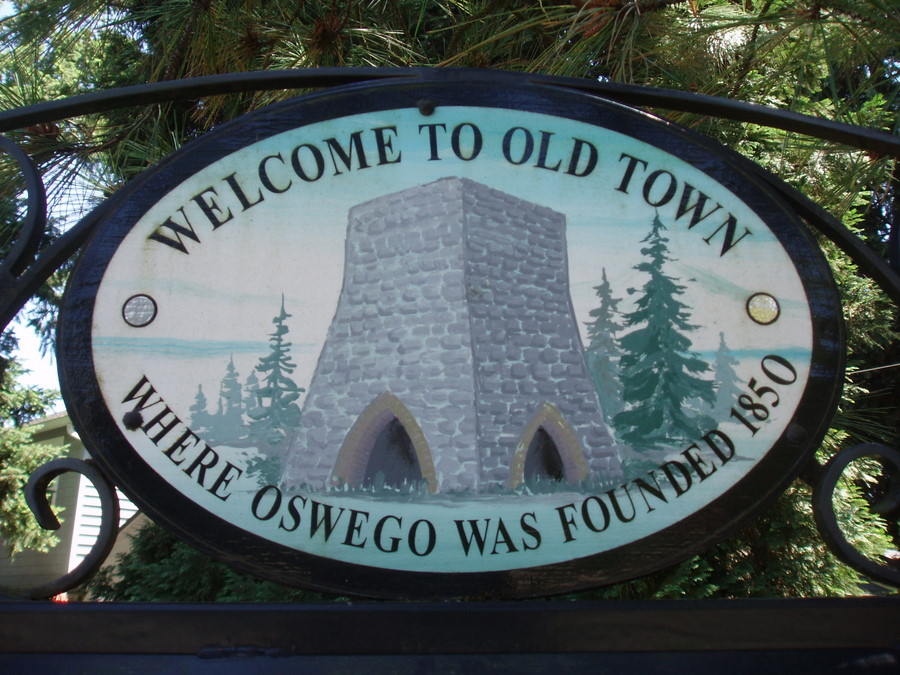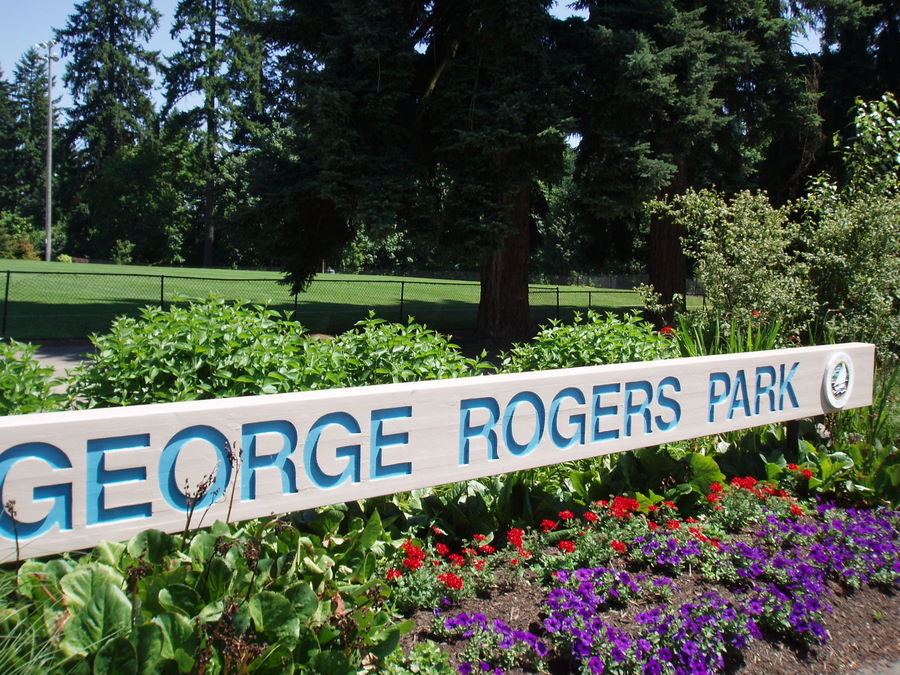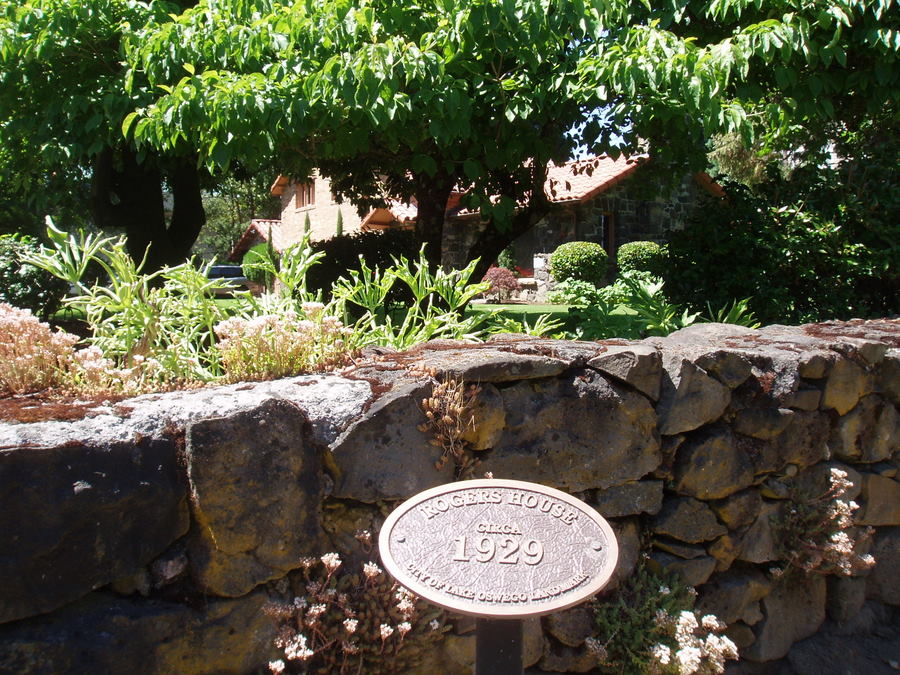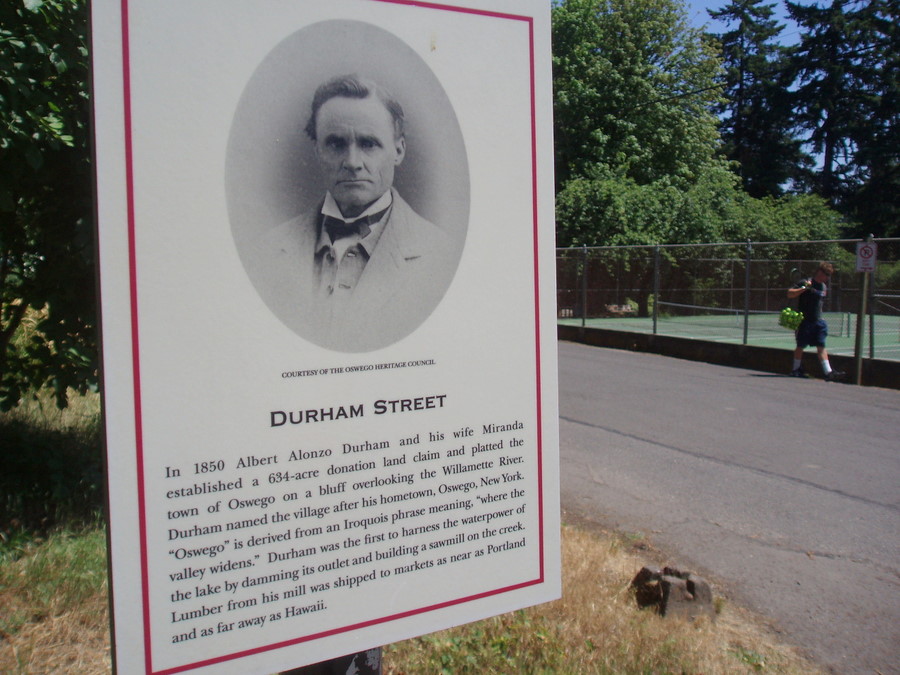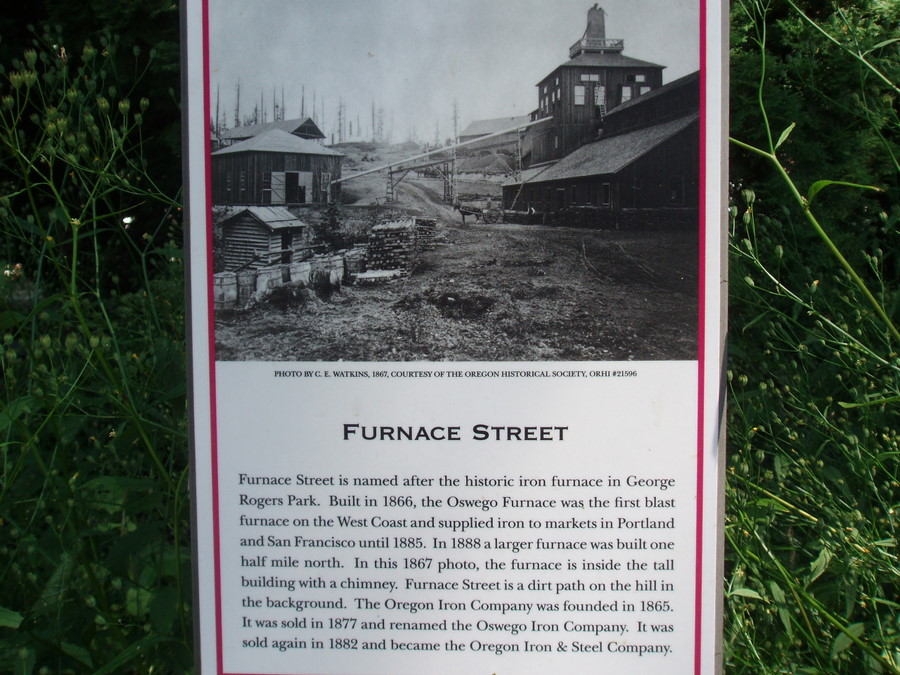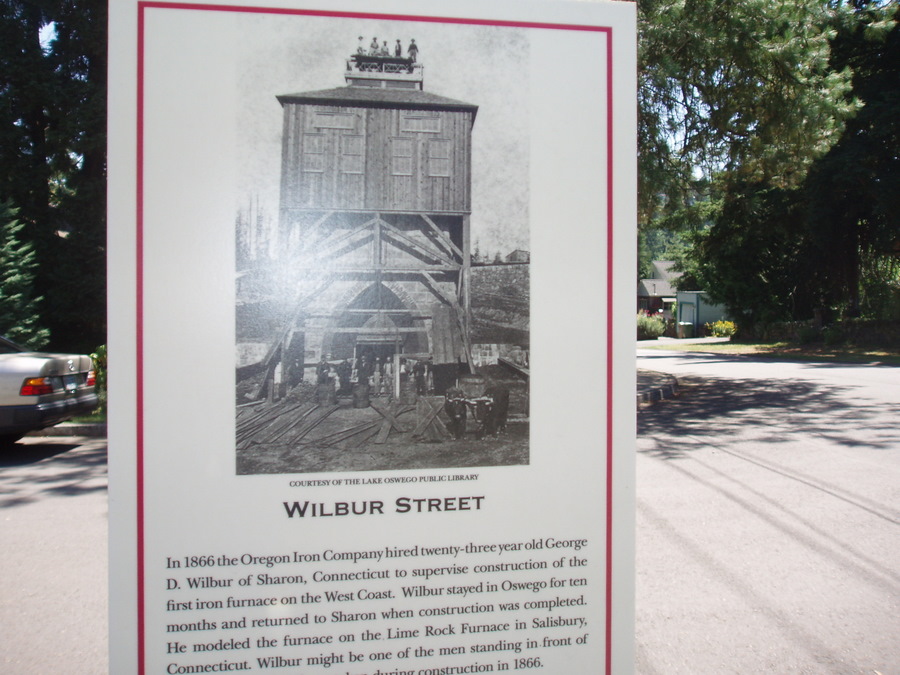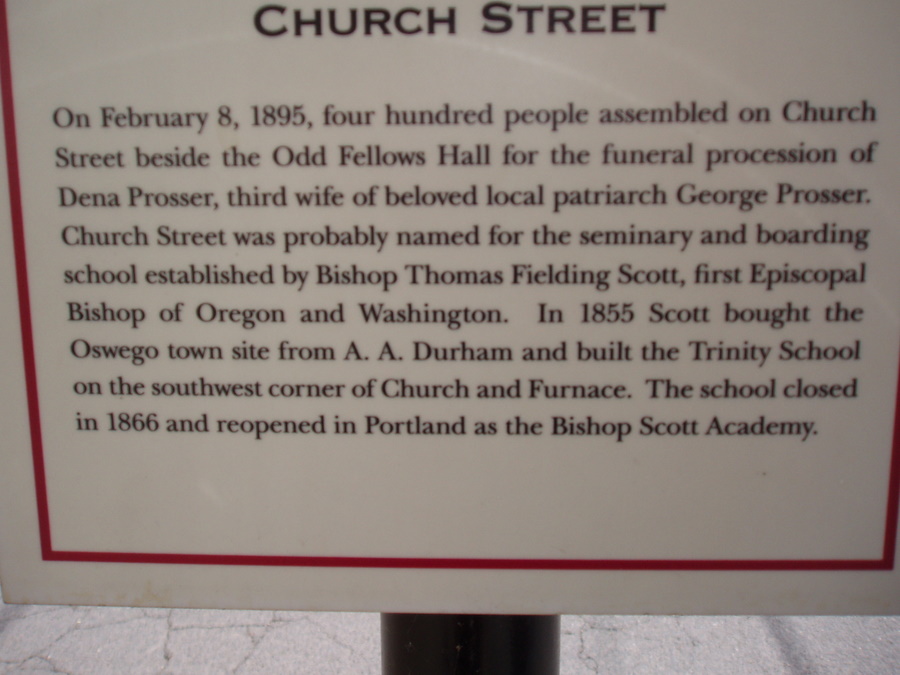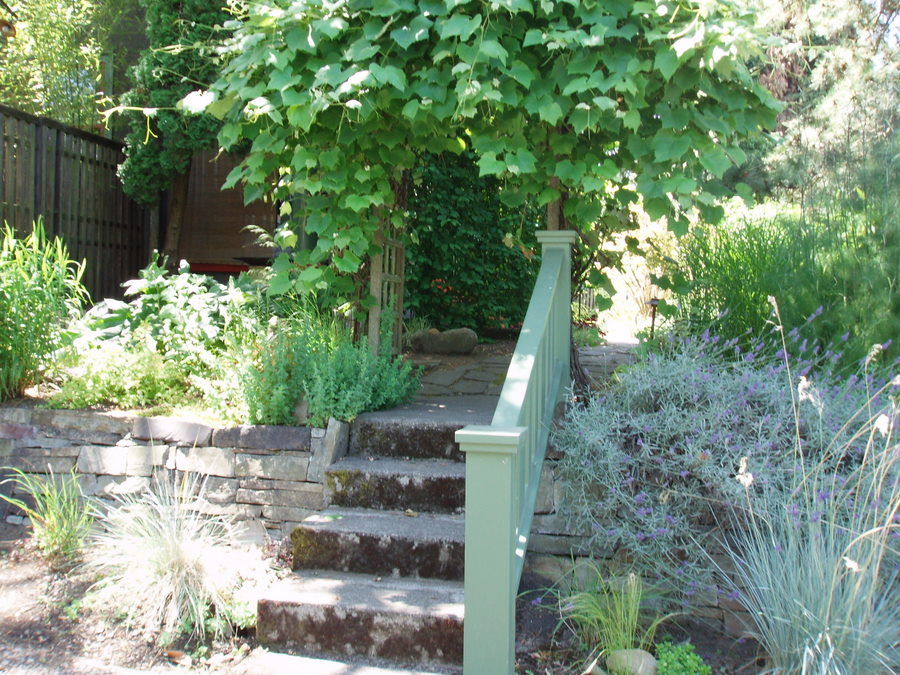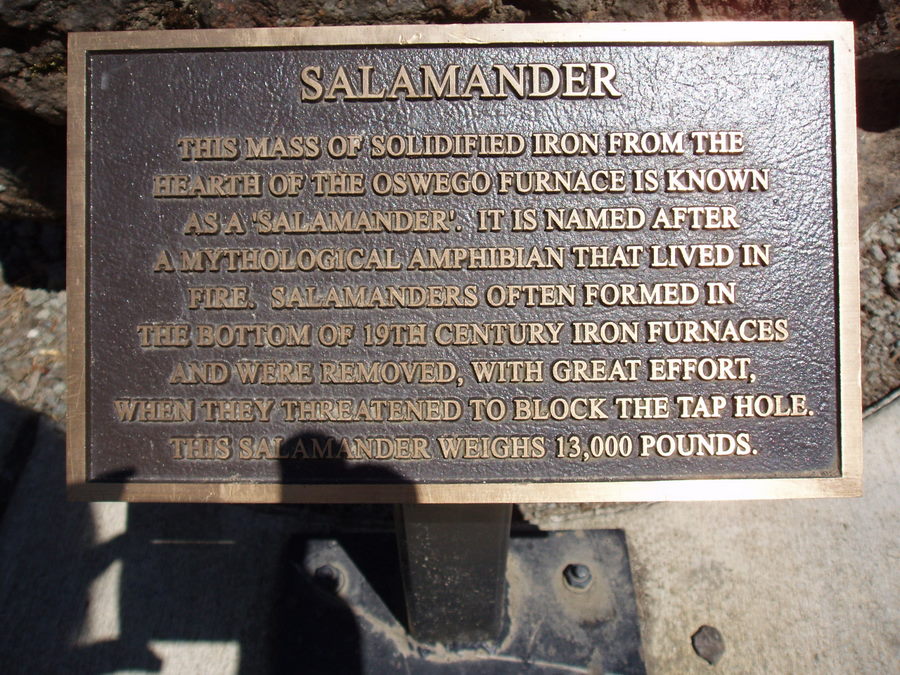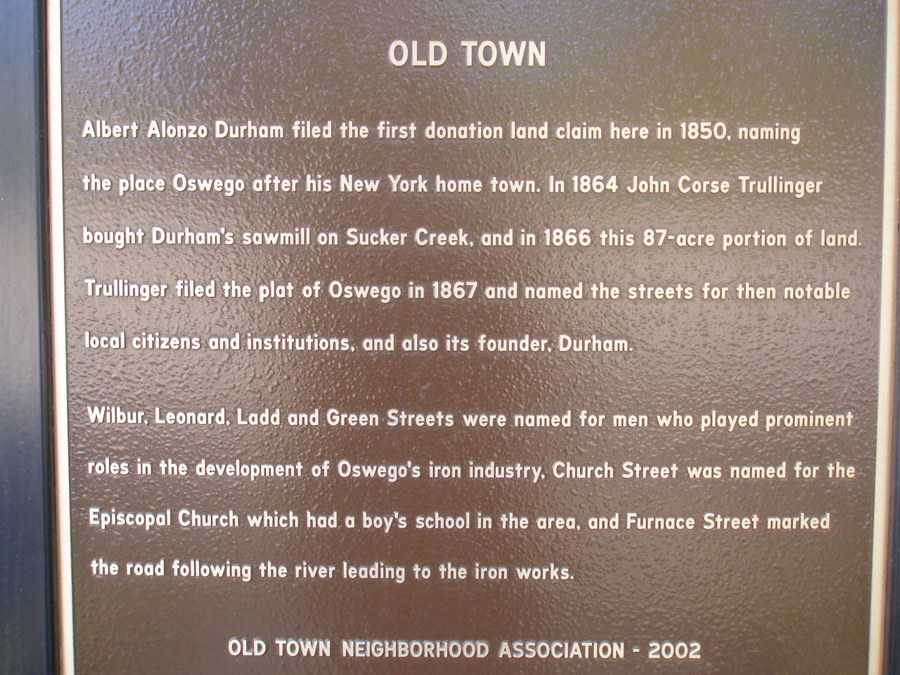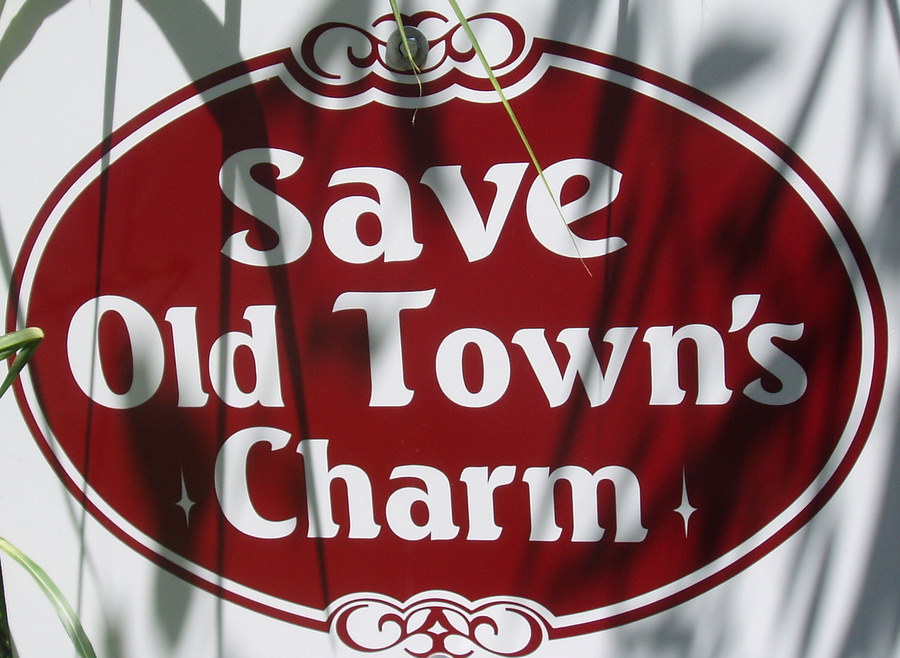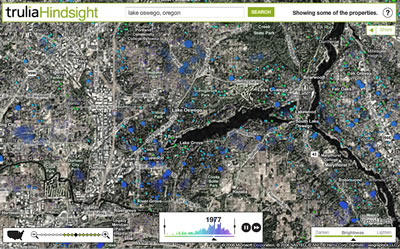Here’s a handy resource to help you orient yourself with the myriad of Lake Oswego neighborhoods. Just open the link below & click the colored segments revealing the neighborhood names:
View Larger Map
Old Town – Historic Pictorial Tour
Dispelling Eight Lake Oswego Myths
 On occasion at the PropertyBlotter, we will lapse into the nostalgic and the historic.
On occasion at the PropertyBlotter, we will lapse into the nostalgic and the historic.
Today, we share a handful of myths concerning the lake, the town, founders, its early industry, and famous headstones.
(Full disclosure: I got this from the very interesting Oswego Heritage Council site).
- Oswego Lake is not an artificial lake. The natural lake was enlarged by successive dams that raised the water level and by a canal that connected it to the Tualatin River in 1873. Lakewood Bay, on the other hand, is largely man-made. It was originally a marsh, known as the Duck Pond. Developers flooded this swampy area in 1928 by digging a channel that linked it to the main lake.
- It is frequently said that Albert Alonzo Durham named Oswego after his birthplace in New York. However, Durham was born in Chenango County, not in Oswego, New York.
- The iron furnace in George Rogers Park is not a “chimney” or a “chimneystack.” This misconception probably stems from the fact that the stone tower containing the smelting chamber is called a “stack.” When it was operating, the furnace was a roaring inferno filled with burning charcoal and iron ore. A 33-foot-tall brick chimney once topped the furnace, but it was dismantled in the late 19th century. The furnace is also sometimes mistakenly called a foundry. An iron foundry re-melts pig iron and casts metal products.
- “Smelter” or “furnace” — what’s the right term? Oswego residents said “furnace” in the 19th century, which explains how Furnace Street got its name. Sometime in the early 20th century, residents began calling it a “smelter.” While this is technically correct, the term used by most historians is “furnace.” In the National Register of Historic Places the Oswego Iron Furnace is listed as the “Oregon Iron Company Furnace” after the company that built it in 1866.
- Oswego was not the first town to produce pig iron west of the Rocky Mountains. The Mormons built a small furnace at Cedar City, Utah in the 1850s. However, the 1866 Oswego Furnace was the first iron furnace on the West Coast. It was also the longest running and most productive of four furnaces built west of the Rockies in the 19th century.
- Oswego’s dream of becoming the “Pittsburgh of the West” was hardly unique. No less than eleven towns with mining or industrial ambitions aspired to this title. Among them were Kirkland, Washington; Richmond, California; Pueblo, Colorado; Eureka, Nevada; Llano, Texas; East Saint Louis, Illinois; and Terre Haute, Indiana.
- The city of Lake Oswego is not named after Oswego Lake. On the contrary, the lake is named after the town. Until 1913 the lake was called Sucker Lake. At the beginning of the 20th century developers searched for a more marketable name, at one time considering “Lake Tualatin.” In 1913 they successfully petitioned the U.S. Geographic Board to change the name to Oswego Lake. In 1960 when the city incorporated much of Lake Grove, the names of both communities were combined and the city was renamed Lake Oswego.
- Linus Pauling is not buried in the Oswego Pioneer Cemetery although there is a headstone there with his name on it. Pauling died in 1994 at his ranch in California. The family placed the headstone in the cemetery to honor his memory in the town where his relatives are buried and where he spent part of his childhood. Pauling’s grandfather was a German immigrant who came to Oregon to work in the Oswego Iron Furnace. Linus Pauling is the only winner of two unshared Nobel prizes: the prize for chemistry in 1954 and the Peace Prize in 1963.
Now, you know the rest of the story.
Source: Oswego Heritage Council. Photo courtesy of City of Lake Oswego.
Mountain Park
Mountain Park is a 700 acre planned community on the East side of Lake Oswego. It was the vision of Carl Halvorson (the man who Halvorson Island, the only private island in Oswego Lake, is named after). Developed in 1968, it is built on a dormant volcano, Mt. Sylvania. The population of Mt. Park fluctuates between 8,000 and 8.500 people meaning that just about 1 in 5 people who live in Lake Oswego live in Mt. Park. It also means that the Mountain Park Home Owner’s Association is one of the largest HOAs in the United States.
was the vision of Carl Halvorson (the man who Halvorson Island, the only private island in Oswego Lake, is named after). Developed in 1968, it is built on a dormant volcano, Mt. Sylvania. The population of Mt. Park fluctuates between 8,000 and 8.500 people meaning that just about 1 in 5 people who live in Lake Oswego live in Mt. Park. It also means that the Mountain Park Home Owner’s Association is one of the largest HOAs in the United States.
Households in Mt. Park include single family residences, townhouses, condominiums, and apartments. Every residence pays a semiannual fee. The fee averages about $400 per year and is used to maintain Mt. Parks extensive common areas. These include 185 acres of trails (15 miles worth!), parks, pathways, 3 tennis courts, and the recreation center.
The recreation center is a gorgeous facility with 2 weight rooms, a basketball court, steam and sauna, a massage therapy center, and community rooms that are available for hosting banquets and receptions. The recreation center offers a variety of classes that are free to members of the Home Owner’s Association: mind/body and traditional fitness classes, and water exercise classes (which are taught at the pool at Lake Oswego High School). There are also youth and adult activities such as game night, Kids Nite Out, Mah Jongg, and seasonal events.
The HOA publishes a neighborhood newsletter called “Parkways and Medley” where you can find out about classes and the current neighborhood events.
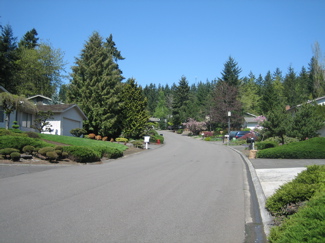 Because the community was planned, and pretty much all built at once, there is a uniformity to the neighborhood with well-cared for lawns and the stately sweep of hillside streets. Pricing goes from a low of $139,900 for a condominium to a high of $699,950 for a 4 bedroom house. Being on a hill, many of the homes and condos have views of Mt. Hood and Portland. Be aware that not all homes in Mt. Park are in the Lake Oswego school district. About 25% of Mt. Park along the North side has Lake Oswego addresses but is in the attendance area for Portland Public Schools. Property values are higher for homes in the Lake Oswego school district.
Because the community was planned, and pretty much all built at once, there is a uniformity to the neighborhood with well-cared for lawns and the stately sweep of hillside streets. Pricing goes from a low of $139,900 for a condominium to a high of $699,950 for a 4 bedroom house. Being on a hill, many of the homes and condos have views of Mt. Hood and Portland. Be aware that not all homes in Mt. Park are in the Lake Oswego school district. About 25% of Mt. Park along the North side has Lake Oswego addresses but is in the attendance area for Portland Public Schools. Property values are higher for homes in the Lake Oswego school district.
The whole idea of a planned community was pretty new back in 1968. Today this sort of community is being built and duplicated all over the country. But Mt. Park was a pioneer of the genre. And it has aged well. The neighborhood is clean and well cared for, and the recreational lifestyle is great.
Palisades
The Palisades neighborhood is located on the South side of Lake Oswego, and is roughly the area bounded by: Stafford/McVey along the south & southeast, Southshore Rd. (down to the lake) along the north, Blue Heron, and then north & east of the Westridge Elementary School area.
It is a lovely neighborhood with a mix of housing ranging in list price currently from $489,900. to $5,950,000.
With this kind of spread, Palisades is known not only for its beauty and liveability, but for the diversity of its neighbors.
These same neighbors will be seen showing up in numbers to the local neighborhood association meetings and volunteering in droves at Palisades Elementary School and Palisades’ own Lakeridge High School.
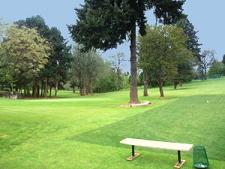 Amenities include the Municipal Golf Course, parks, a dog park, community swimming pool, and the new “boutique” senior living center, “The Stafford”, which is situated across the street from the high school, three athletic fields and yet another dog park. This location, we are told, was intentionally chosen in order to meld the young and the elderly in a real community atmosphere where all phases of life are acknowledged and celebrated.
Amenities include the Municipal Golf Course, parks, a dog park, community swimming pool, and the new “boutique” senior living center, “The Stafford”, which is situated across the street from the high school, three athletic fields and yet another dog park. This location, we are told, was intentionally chosen in order to meld the young and the elderly in a real community atmosphere where all phases of life are acknowledged and celebrated.
An especially delightful aspect of the Palisades neighborhood is the access to superior services just across the borderline streets of Stafford/McVey (therefore not technically in Palisades, but rather in the McVey-Southshore neighborhood).
Kids bike to Bellagio’s Pizza, shirts are picked up at the dry cleaners, dog-walkers congregate at Starbuck’s, lunches and dinners are wonderful at the Thai Curry-In-A-Hurry restaurant, birthdays and anniversaries are remembered with the help of three gift shops, and sunny days find everyone milling at the garden center.
All of it adds to the charm of this lush, green community by the lake with a distinctive ‘small town within a town’ feel.
One of the best things about Palisades (in my humble opinion) is Palisades Market. This is a locally-owned market with some of the nicest people you’d ever want to meet making sure that you’ve found every little thing.
I shop there sometimes just to relax… I’m not kidding! I often joke to friends that the people who work at this wonderful place come from Planet Palisades, as they all seem to genuinely enjoy their work and treat customers like old friends. This is a kind of Neighborhood Central. You’ll find Lakeridge ‘Pacer’ apparel is displayed and sold proudly. Cans and bottles are donated in special receptacles by the crate-load with neighbors supporting the local school of their choice.
There is an adjoining post office annex & the Coffee Nook, a florist, a deli, wine shop, specialty meat shop, bakery and often dinner cooked & ready to be served for take-home by yet another friendly employee… a chef this time. The store is owned by Bob Lamb, Gale Casko, and Nick Goldsmith who is ever-present and always catering to customers’ needs.
Originally a much smaller store it was located where the pizza parlor, restaurant and cleaners are now, moving in 1997 to its current location just up the block, and boasting 25,000 SF of friendly service.
Palisades Market had a rocky start, not owing to the fact that the site was originally a gravel pit, but rather to red tape that almost nixed the plans. True to form, neighbors rallied to support the new store, and Palisades, McVey-Southshore and Hallinan neighborhoods all now enjoy the fruits of that effort.
All in all, Palisades is a lovely place to live. Homes to suit any preference are to be found, and neighborhood character is in full bloom.
Lake Grove
 Lake Grove is located West of Oswego Lake and East of Interstate 5. It includes a vibrant business district along Boones Ferry Rd with many shops, offices, and restaurants. The neighborhood was platted in 1912 and grew as a result of the Goodin Station train stop between Oswego and Tualatin. The old train station and market were long ago converted to a very charming residence and can still be found today. If I were trying to find a word to describe Lake Grove it would be “diverse”. There is just simply a very wide variety of housing and businesses in Lake Grove.
Lake Grove is located West of Oswego Lake and East of Interstate 5. It includes a vibrant business district along Boones Ferry Rd with many shops, offices, and restaurants. The neighborhood was platted in 1912 and grew as a result of the Goodin Station train stop between Oswego and Tualatin. The old train station and market were long ago converted to a very charming residence and can still be found today. If I were trying to find a word to describe Lake Grove it would be “diverse”. There is just simply a very wide variety of housing and businesses in Lake Grove.
Housing is both modest and grand. On the modest end of the spectrum are condominiums starting at about $135,000 and single family homes starting at $289,900. On the grand end is a newly built home that is currently for sale for $1,790,000. That’s a pretty broad range of housing! Architectural styles include 1920’s bungalows, mid-century homes of the 1940’s and 1950’s, ranch-style homes from the 1960’s and 1970’s, and the more large-scale homes that became popular in the 1980’s and are still being built today.
With so much diversity Lake Grove has known for years that a plan was needed to be put in place to create some harmony. The Lake Grove Neighborhood Plan was adopted in 1998 to guide development of open spaces, historic and natural resources, economic development, housing, and transportation.
The look of the neighborhood is characterized by large stands of very tall fir trees. Much of the area has a woodsy feel to it. Most residential lots are large. Some parts of Lake Grove are actually not incorporated into the City of Lake Oswego, but are considered to be in Clackamas County. The pockets of unincorporated land enjoy Lake Oswego addresses and city services such as water and schools, but are served by the County Sheriff rather than Lake Oswego police.
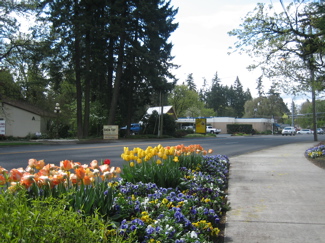 The City of Lake Oswego has spent the last decade doing a major overhaul of its commercial districts. Millenium Plaza Park and the Village Center at the East end of town were completed through this revitalization effort several years ago and have been wildly successful. A similar effort is just beginning in Lake Grove. The Lake Grove Village Center Plan calls for improved pedestrian access and extensive landscaping improvements. It has been in the planning stage for several years with actual construction scheduled to begin soon.
The City of Lake Oswego has spent the last decade doing a major overhaul of its commercial districts. Millenium Plaza Park and the Village Center at the East end of town were completed through this revitalization effort several years ago and have been wildly successful. A similar effort is just beginning in Lake Grove. The Lake Grove Village Center Plan calls for improved pedestrian access and extensive landscaping improvements. It has been in the planning stage for several years with actual construction scheduled to begin soon.
By far one of the great advantages to living in Lake Grove is the easy access to I-5 North to downtown Portland or South to Salem, Hwy 217 West to Beaverton, and Hwy 205 East and North to Mt Hood and the Portland airport. There are two large shopping areas nearby: Washington Square and Bridgeport Village. It is just simply a very convenient place to live.
So if you like a neighborhood that is not a subdivision, where there is a mix of houses and house styles, where there are large lots and big trees, and where you have easy access to shopping, restaurants, and the Westside’s main highways, Lake Grove just may be the neighborhood for you.
First Addition
 First addition is one of the Portland area’s most charming and desirable places to live. It was platted in 1888 and is actually Lake Oswego’s second oldest neighborhood. (The oldest is the historic old town area near George Roger’s Park). The neighborhood was the first growth outside of Old Town as the economic focus of the town shifted from the production of iron and steel to the pursuit of recreation. The neighborhood has about 30 blocks of historic homes. A tour of homes will allow you to see Gothic, Craftsman, Colonial Revival, Vernacular, and English Cottage styles.
First addition is one of the Portland area’s most charming and desirable places to live. It was platted in 1888 and is actually Lake Oswego’s second oldest neighborhood. (The oldest is the historic old town area near George Roger’s Park). The neighborhood was the first growth outside of Old Town as the economic focus of the town shifted from the production of iron and steel to the pursuit of recreation. The neighborhood has about 30 blocks of historic homes. A tour of homes will allow you to see Gothic, Craftsman, Colonial Revival, Vernacular, and English Cottage styles.
One of the great features of the location is that it is a short walk to many of Lake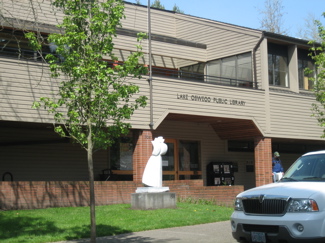 Oswego’s most popular attractions. The neighborhood hosts the Lake Oswego Public Library and the Adult Community Center. It is also adjacent to the Village Center with its boutiques and restaurants, as well as Millenium Plaza Park which is the location of the Farmer’s Market. As if that weren’t enough, directly North of the neighborhood is Tryon Creek State Park with its miles of trails for hiking, jogging, and even horse back riding.
Oswego’s most popular attractions. The neighborhood hosts the Lake Oswego Public Library and the Adult Community Center. It is also adjacent to the Village Center with its boutiques and restaurants, as well as Millenium Plaza Park which is the location of the Farmer’s Market. As if that weren’t enough, directly North of the neighborhood is Tryon Creek State Park with its miles of trails for hiking, jogging, and even horse back riding.
First Addition has a very active Neighborhood Association that works to preserve the historic flavor of the neighborhood, to keep the area pedestrian friendly, and to preserve the many large trees. There is a 100+ year old sugar maple tree on the corner of 3rd and C Avenues that is beyond spectacular when its leaves turn orange in the fall.
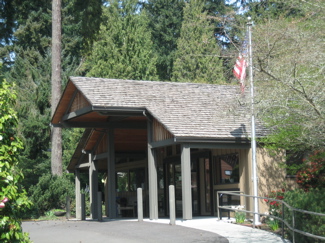 Adding to the convenience of living in First Addition is the fact that it also contains Lake Oswego’s Tri-Met transit center with bus to downtown Portland and the rest of the metropolitan area.
Adding to the convenience of living in First Addition is the fact that it also contains Lake Oswego’s Tri-Met transit center with bus to downtown Portland and the rest of the metropolitan area.
In 2006 Cottage Living Magazine named First Addition one of the ten best cottage communities in the United States. It raved about the quaint homes, the easy walk to attractions, and the “jewel box gardens winking from behind picket fences”.
First Addition is an awesome place to live that features quaint and historic homes along with easy convenience to many great attractions. When you buy a home in First Addition, you are not just buying a house, you are buying a lifestyle.
For our regular subscribers, if you would like to access past articles in our archives, please click here.
A Birds-Eye View of Lake Oswego Home Construction
Whether you’re in the market for a home in Lake Oswego or not, check out this cool mashup of maps and home construction history.
Developed by online real estate listings site Trulia, this application, called Hindsight, plots a sampling of an area’s home construction dates on top of a Microsoft Virtual Earth map. A timeline automatically starts scrolling from around the turn of the 20th century and as homes were built over time, they ‘bloom’ on the map.
The screen image shown here isn’t particularly evocative of the animation, so click on the image or here to experience it.
The Hindsight viewer shows the peak construction periods in Lake Oswego to be the mid 50’s, then throughout the ’70’s, and finally, a boom in the 90’s.
The best way to view this is to stare at the middle of the screen and let your peripheral vision absorb the data as the timeline scrolls. Zoom in for a little more detail, or zoom out to see the Portland metropolitan area.
Is this useful? Well, if you’re not familiar with Lake Oswego, you can pause, then slowly advance the scrollbar on the timeline to see where the homes of your preferred era have been built. For example, if you’re looking for the highest ratio of homes built in the 90’s, you might be attracted to the Westlake area. First Addition might appeal to vintage homeseekers.
Use it for research, or just for fun. Link to Lake Oswego Hindsight map

